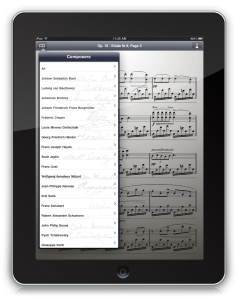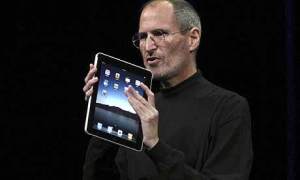 A number of apps have been released to read music on the iPad. There are four main categories these apps fall into, as far as I can see:
A number of apps have been released to read music on the iPad. There are four main categories these apps fall into, as far as I can see:
1. Apps that read (and recognize) your music.
2. Apps that read everything.
3. Apps that allow paid downloading from a single source
4. Apps that display music included with the app
Here’s a breakdown of some of the apps that fall in each category, as well as some features of each.
Apps that read your music:
MusicReader (free, $59 or $99 Mac or PC version required) – A comprehensive music reading app, which recognizes measures and displays on the iPad in either full or half page (landscape) modes. All kinds of image files are supported by the program, not just PDF’s. Annotation and playlist support are inlcuded, and the app has been updated several times, showing an active development team. The iTunes description boasts integrating with an available music stand and an upcoming foot pedal.
Apps that read everything:
Forscore ($4.99) – A music centered app that reads PDF’s. It doesn’t recognize the music on the page, but instead adds a metronome, the ability to create playlists, and tools to annotate your music.
Good Reader ($.99) – While not a music reader specifically, Good Reader reads PDF, TXT, and all Microsoft Office and iWork formats, plus more. Good Reader can use USB file transfer or link over WiFi to a computer or Mobile Me account. Good Reader does not support annotating, but is a simple viewer and cataloger of PDF files, music included.
Unreal Book ($4.99): This app features many of the reading capabilities of apps like Good Reader, but adds the capability to bookmark as well as iTunes library playback controls in-app.
Apps that allow paid downloading from a single source:
MusicNotes Sheet Music Reader (Free) – This app only syncs proprietary files downloaded from Musicnotes.com. It offers annotation, a metronome, and bookmarking. Ironically, this app’s biggest limitation – only reading music purchased from Musicnotes – is also it’s greatest strength: it’s legal, folks. While I’d argue a single copy of sheet music you own being used on your iPad is within Copyright fair use, putting the music on a classroom full of iPads is a gray area, even if you own 40 physical copies. With purchases from Musicnotes, using them on the iPad is part of the license, even if using it on 40 might not be.
Apps that display music included with the app:
iReal Book ($7.99): 900 standard charts are included with this app, which is designed to run on both the iPad and iPhone/iPod Touch. While it doesn’t include lyrics, it does show changes, with the ability to alter the chords shown, and to change the key of the piece. The app promises one-page charts for all songs, so the player can keep his hands on the keyboard.
One more thing:
If you’re looking into using an iPad to read your music, you may need to transfer your files to the PDF format. In my case, I’ve been scanning music into my computer in TIFF format for optical character recognition (OCR) using SmartScore for years. If you have files in any graphics format you’d like to convert to PDF, I recommend the Mac program Graphic Converter ($34.95, functioning demo available). It includes a batch converter that can read a series of nested folders (like I have) and make every appropriate file into a PDF. I converted about 250 choral octavos into PDF in a few minutes, uploaded them to my iPad via Mobile Me, and brought them into Good Reader, and now I have an entire choral library at my fingertips!
If you’ve used an iPad music reading software you feel deserves mention – post your comments below!



 Posted by Dave Martin
Posted by Dave Martin 


